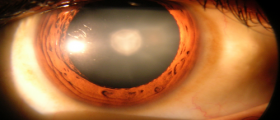
The middle layer of the eye is also called the uvea or the uveal tract. When that part of the eye gets inflamed, a person is considered to be suffering from a certain condition known as uveitis. There are three parts that the uvea consists of and they are the iris, the ciliary body and choroid. Iris is the colored part of the eye. The ciliary body is a ring of muscles which is located behind the iris and the choroid is the layer of tissue whose main purpose is to provide support for the retina.
Middle layer of the eye
There are several symptoms and signs of uveitis and it is important that a person goes to the eye care specialists as soon as he or she experiences them. This signs are known to lead to various other complications if they are not treated on time. Some of the earliest signs that are seen with this condition are pain in either one or both of the eyes, redness of the eye and blurred vision. When causes of this condition are considered, there are a lot of them. The experts believe that there are over than a 100 causes of uveitis. An underlying condition, infection and an injury to the eye are the most commonly seen causes. However, discovering the actual cause of uveitis is not an easy task for the doctors and the data claims that in 30% of all cases the actual cause cannot be discovered. A person who experiences pain in the eye or even the smallest change in vision should immediately go to the hospital and seek medical advice. This is especially important in cases where a person has already suffered from uveitis. Immediate treatment is essential in order for the permanent damage to the vision to be avoided. According to the data in England, more severe types of uveitis are known to be responsible for 10% of all cases of blindness. A person who is diagnosed with this condition will undergo a certain treatment. This treatment is usually the use of corticosteroids because they are excellent when it comes to reducing the pain and inflammation. However, there is no one treatment available and it will depend on several factors. The experts say that there are three types of uveitis. The actual type depends on the part of the eye that is affected. Anterior uveitis is the most common type of this condition and it is an inflammation of the iris alone or of the iris and the ciliary body. If only iris is inflamed then the case is known as irits, while in the other case the medical name is iridocyclitis. This type of uveitis occurs in more than 75% of cases and it is considered to be the least dangerous. The second type is called intermediate uveitis and it affects the area behind the ciliary body and the retina. This type occurs in less than 20% of all cases. Children, teenagers and young adults are more prone to this type than people of other ages. If the inflammation is seen at the back of the eye, the choroid and the retina, then a person is thought to be suffering from posterior uveitis. In case of this type of uveitis, there is almost always an underlying autoimmune condition such as rheumatoid arthritis for instance. Posterior uveitis occurs in one out of every five cases of uveitis. According to the experts, this condition of the eye is not considered to be common and one out of 4,500 people is affected by it every year in England. Even though one type of this condition is more common in children, uveitis usually occurs in people between 20 and 59 years of age. Both men and women are affected by it. Early treatment is essential because uveitis is the leading cause of blindness, even though it is not common.
Associated complications of uveitis
Every person diagnosed with this condition can experience certain complications but they are usually seen in those who suffer from chronic uveitis. In addition to this, those older than 60 years of age are more likely to experience them. There are three complications which are seen in most cases and they are glaucoma, cataracts and cystoids macular oedema. If treatment is not received as soon as possible, the iris can stick to the front of the surface of the lens and that will prevent normal fluid drainage through the pupil. Due to that, there will be more pressure inside the eye. If that happens a person may experience damage to the optic nerve and damaged normal vision. This condition is known as glaucoma and the possible treatments are eye drops, laser treatment and surgery. In case of cataracts a person will experience cloudy patches on the surface of the lens. These cloudy patches develop due to an inflammation inside the eye which causes the irritation of the lens of the eye. Signs of cataracts are blurred vision, difficulty seeing clearly at night and unusually faint colors. Surgery is the best treatment option in case of cataracts. Cystoid macular oedema is mostly seen in people with chronic uveitis. This problem occurs due to prolonged inflammation which causes a build-up of fluids inside the retina. In this case, the best treatment option is the use of corticosteroid eye drops.

















Your thoughts on this
Loading...